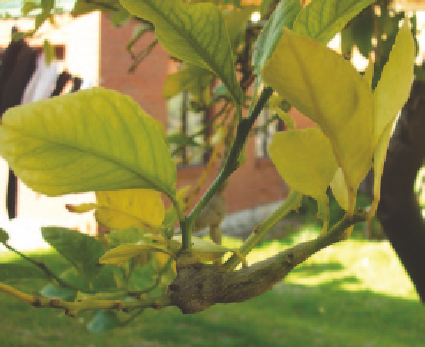Agriculture Reference
In-Depth Information
Fruitthinning
Mandarins are the only one of this tribe to
need serious fruit thinning. They can be
prone to biennial bearing so thin about every
young fruit in four to ensure regular crops.
There are various rootstocks available that
confer disease-resistance, tolerance to
differing soils and determine the ultimate
size of the tree. Citronelle or rough lemon
makes a large vigorous tree needing sharp
drainage in light soils. The citrange stocks are
smaller with better disease-resistance, and the
trifoliate stocks are smaller again and are
tolerant of disease and heavy soils. The most
dwarfing rootstock is Flying Dragon and
perfect for citrus in pots. It is slow growing
and therefore more expensive, but ideal to
dwarf your selected cultivar. A reputable
nursery should be able to select what is best
for your area and needs, and also ensure that
the plant is virus tested.
Maintenance
Always remove crossed and crowded growth
to keep the centre of the tree open. Diseased
and dead wood should also be dealt with as
you see it (see Figure 8.2).
Lemons are the only ones that need regular
attention to prevent the branches from
becoming too long and leggy. Shorten back
the long stems by about a third to an outward-
facing bud and thin the old fruiting wood as
required (see Figure 5.25, page 139). In hot
climates or after severe pruning that exposes
once shaded bark to the sun, the major stems
should be painted with white water-based
paint to prevent sunburn.
Fruitingwood
Flowers and fruit are produced from the leaf
axils of young growth. Depending on your
climate, lemons can flower and fruit year
round while most other citrus have one
flowering and fruiting period. Kumquats
flower in summer while the rest bloom in
spring. The time from blossom to harvested
fruit will also vary with climate.
Pruningtime
In warm, frost-free climates prune any time
that takes your fancy. Those who experience
frost should not prune until the danger is
over some time in late spring. Prune just
before the spring flush of growth if the
climate is somewhere in the middle.
As most citrus do not need much trimming,
prune as you harvest by cutting the fruit from
the tree with a length of stem attached. Prune
back to the next leaf or more if the growth is
becoming straggly.
Figure 8.2
Citrus gall wasp has caused the swelling on
this branch. Cut it out as soon as you see such a growth
to prevent it spreading. Destroy the stem as it may still
harbour the wasp or its eggs.

